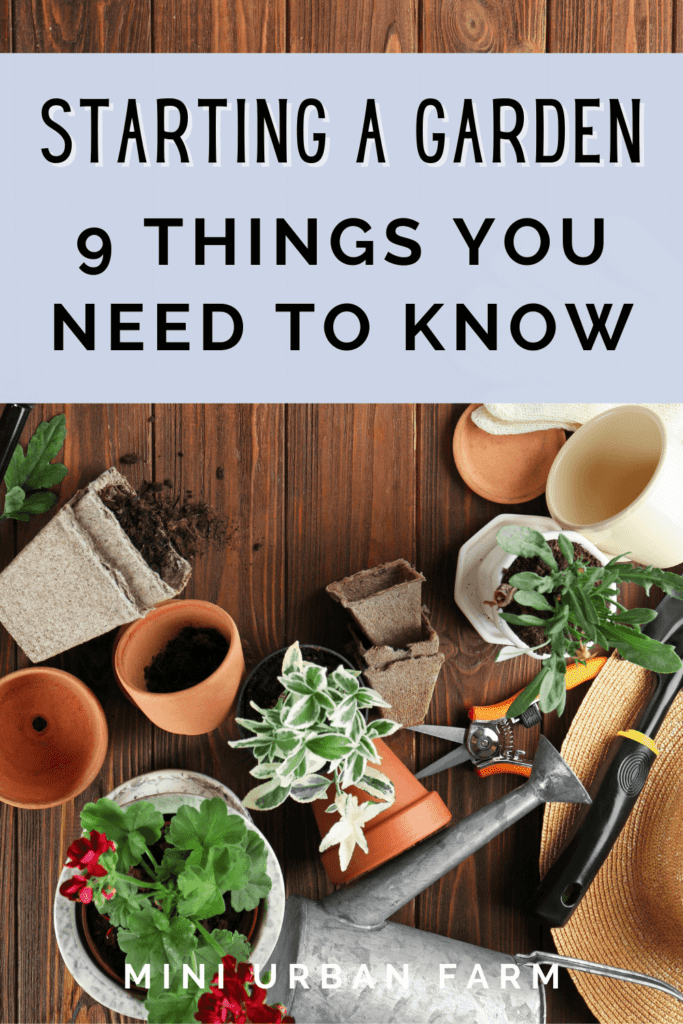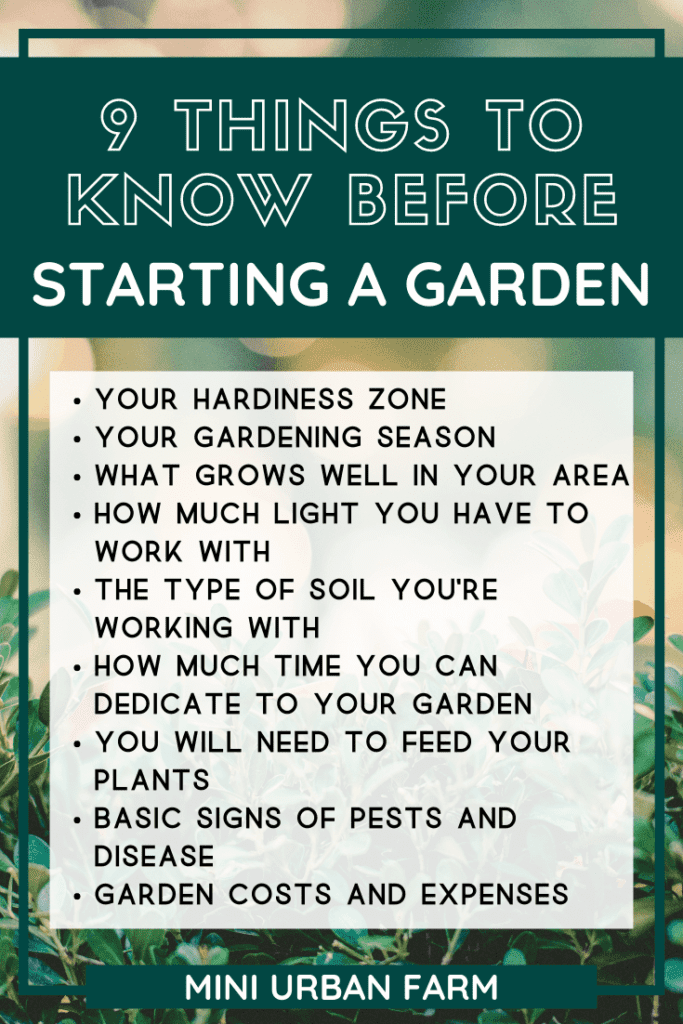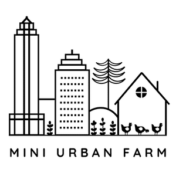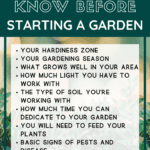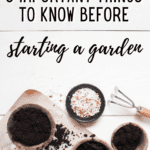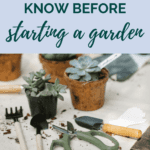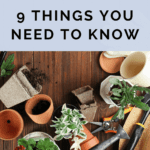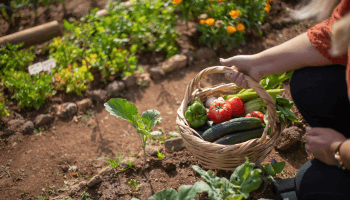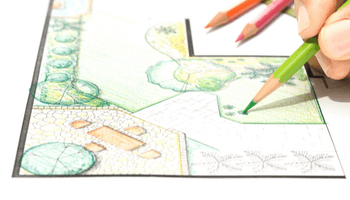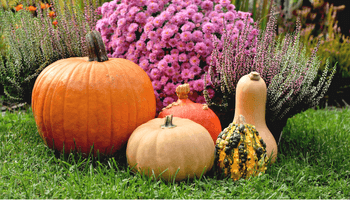So you want to start a garden, but you have no clue how to begin. We’ll don’t worry! We’re all beginners at some point, and you just need the right info to get you started! But before you head to the garden center and start picking out plants, there’s a few things you have to know in order for your garden to be successful. And seeing as I’ve had my fair share of gardening hiccups along the way, I’ve put together this list of things to know before starting a garden!
9 Things to Know Before Starting a Garden:
- Your hardiness zone
- Your gardening season
- What grows well in your area
- How much light you have to work with
- The type of soil you’re working with
- How much time you can dedicate to your garden
- You will need to feed your plants
- Basic signs of pests and disease
- Garden costs and expenses
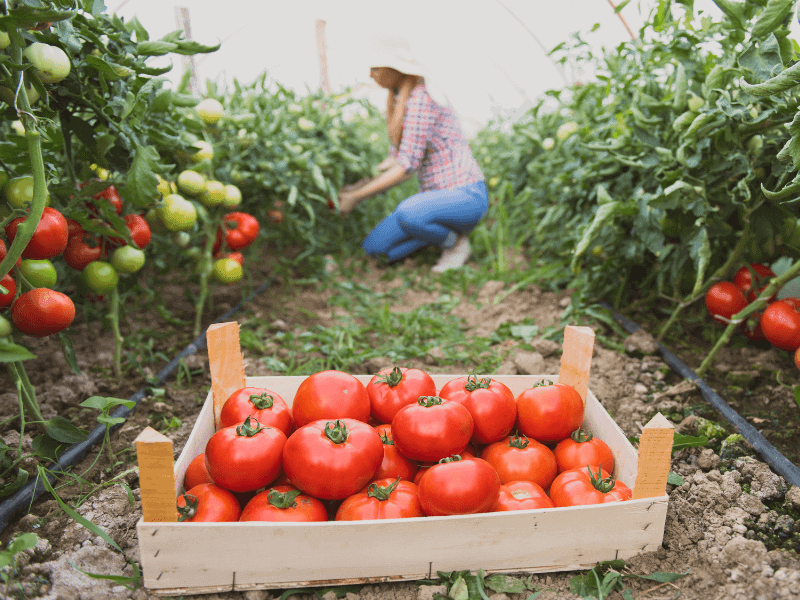
Disclosure: This post may contain affiliate links. If you purchase a product through one of our affiliate links we make a small commission from the sale at no extra cost to our readers.
Things to Know Before Starting a Garden
In reality, you can start a garden without any gardening know-how, and things might work out fine.
Or (the more likely scenario) – you’ll have some minor set backs and hiccups which lead to frustration and a less than productive garden.
I know that was the case when I started getting serious about gardening – I didn’t know what I didn’t know.
So in this post I’m hoping to give you the basics of what to know before starting a garden so that you don’t run into any major surprises. And trust me – harvesting tons of vegetables at the end of the season is so worth the time it takes to prepare!
And if you’re looking for a complete step by step guide to starting your garden, check out my gardening workbook!
1. Your Hardiness Zone
This is the number one mistake I see new gardeners make! And really it’s not your fault at all.
You go into the garden center and pick out a nice starter pack of salad greens. They look so cute with all different colored leaves and you can’t wait to plant them in the ground.
Only it’s the middle of summer and you live in Central Florida.
If you’re a complete beginner you might not realize that those little lettuce plants are destined to fail. Not because of anything you do, but because salad greens are (usually) a cool weather crop.
And the middle of summer in Central Florida is hotter than H-E-double hockey sticks!
And you would think that you can trust the garden center to only stock plants that will actually do well. But unfortunately this is not the case.
So – the first and most important thing to know is your hardiness zone.
Now, this term gets thrown around a lot in gardening. And it can seem more complicated than it is.
But really it just means “how cold does it get where you live, and when does it get cold.”
I paraphrase, of course. But that’s how I remember it.
Essentially the USDA Hardiness Zone map is a map of each part of the United States, but broken up into 13 different zones based on climate. You can check out the official map here and find your zone by entering your zip code.
Once you know this piece of information, everything else becomes much easier!
2. Your Gardening Season
Now that you know your gardening zone, it’s time to do a bit of research.
Start out by searching “your zone” frost dates. So for example I would search “zone 9b frost dates.”
That will give you the first and the last estimated frost dates for your region. Keep in mind that these are estimates, not hard and fast dates.
So why is this important?
Well, most things you’ll want to grow won’t survive a frost (basically when the temperature drops below a certain point.) And other things – like kale and parsley, will do just fine with some frost.
But you will need these dates to determine your main gardening season – when you’ll be able to plant out most things. And (very importantly) when you can plant things out.
Because some veggies will need 90 days to mature (and produce fruit). And if your first frost date is October 1st, you probably shouldn’t waste your time planting out those seeds on September 20th.
So based on those dates, you can determine how much time you have to plant – your gardening window so to speak – and plan accordingly.
Gardening in Warmer Zones
Now – I do have a caveat to include for the warmer zones.
I live in Central Florida, zone 9b. Which means that in summer the temps go well into the 90s F on some days.
Most things won’t grow in that kind of heat. And if they don’t totally fry, they sure won’t be setting fruit.
Which means that I have 3 options for gardening in June, July, and August where I live:
- Give my garden a rest during that time (something a lot of gardeners down here do)
- Grow things that can take the heat (usually what I like to do)
- Create a cooler environment in your garden using shade cloth and other products
All three of these options are fine, but my main point is that you need to know your gardening season.
So do some research on planting maps for your area – and if you see that nothing is growing on certain months of the year, do more research to find out why!
Psst…want to fast track your garden? Get access to my FREE gardening resource library and start maximizing your garden today!
3. What Grows Well in Your Area
Okay, so now that you have your hardiness zone and your frost dates, it’s time to find out what will actually grow in your region.
Usually this is based on your frost dates (how much time the plant has to grow) and how cold it actually gets.
But never, and I mean never, trust the gardening center when it comes to picking out plants.
Because on multiple occasions I have seen my local garden center selling apple trees – something that does not grow in Florida.
So take some time to familiarize yourself with what grows well in your zone.
And if you want to know about a specific plant, all you have to do is look up “plant” hardiness zone. For example, peach tree hardiness zone. That will tell you that peach trees grow best in zones 6-8. So here in zone 9 I probably shouldn’t expect a peach tree to do well.
However – there’s one thing you should keep in mind. Every type of fruit and vegetable has multiple varieties. So just because “normal” peach trees don’t do well in zone 9, that’s not to say that all peach trees won’t grow.
I am currently growing a UF Best peach tree which was specifically developed for my area and needs fewer hours of cold weather.
And on the flip side – if you want to grow a tropical plant, you can always bring it inside when the temperatures drop!
But what will ultimately grow well in your area is easy to determine – one of the many gardening topics I cover in my Starting Your Urban Vegetable Garden workbook!
4. How Much Light You Have to Work With
Alright, so now that you know the basics of what will actually grow in your area and when, it’s time to focus on your actual gardening space.
Starting with the amount of light you have where you’ve chosen to plant your garden.
Generally, South facing gardens are best for maximizing sunlight.
But I’m a big fan of working with what you’ve got – so if your garden faces any other direction you can still make it work!
Determining how much light you have is really simple – you just have to observe your space!
Take a look at your chosen space at different times throughout the day.
When does it start getting sunlight? At what time does it get completely shaded out? How many hours of light does the space receive per day?
Based on the answers to those questions, you can decide what to plant. For example, if your garden only gets a few hours of light since the house shades out the space the rest of the time, you won’t be able to grow things that require full sun.
So your best option is to look into what types of things grow well in the shade (salad greens are my favorite for shady areas!)
And often times there will be parts of your garden space that get more sunlight than others. Plant your crops accordingly to get the best harvest!
5. The Type of Soil You’re Working With
For beginner gardeners, this one can get a big tricky. So I’ll keep it simple.
If you go outside and dig up some dirt, it will likely look different from another patch of dirt across the city. That’s because the types of soil are different depending on where you live.
But unless you’re working with really poor soil types like straight up clay, you shouldn’t have a problem growing veggies as most plants will adapt to the soil. And you can amend the soil for any lacking nutrients.
However, if you notice the ground is very very sandy, or you literally cannot dig through the dirt at all – it might be time to consider a raised bed garden.
Which basically means you build a box on top of the ground and fill it with better soil.
In a raised bed garden it’s easier to control the soil type and nutrients that your plants are getting, but you’ll have to water more and it’s definitely more expensive than gardening in-ground.
I’ve had raised bed gardens for years and you can find my complete guide to raised bed gardening right here!
6. How Much Time You Can Dedicate to Your Garden
This is hands down one of the biggest mistakes that I see new gardeners make!
They set up their garden, plant in all their seedlings, and then everything is good for the first couple of weeks.
After that life takes over.
You guys – gardening is work. And definitely worth it, but still – work.
Which means that if you don’t have the time to dedicate to your new garden, you either have to make the time or your plants won’t survive.
Now, there are definitely ways to save time in the garden. Things like setting up systems and knowing what to look for on your garden walks.
But you need at least a few hours a week if you’re actually going to grow food.
On average I spend about 2-4 hours per week in my garden. And it wasn’t really that much more when I had a bigger garden.
In fact, I break down the exact time it takes me to garden in this post. But overall, you will need to dedicate time to this new hobby!
7. You Will Need to Feed Your Plants
Plants are just like people – they need the right conditions and they need to be fed in order to survive!
Which means that your job is not done when you put them in the ground!
Now, “plant food” isn’t a one size fits all. Different plants will need different nutrients. And if they can get that from the soil then great.
But if your plants need something that is lacking in your soil, you’ll have to supplement with fertilizers.
My go-tos are always homemade compost, worm castings, and blood and bone meal. But, be careful because over-fertilizing can burn your plants!
Which brings me to….
8. Basic signs of Pests and Disease
Knowing some basic signs of pests and disease will help you determine when your plants need something.
As a rule of thumb in my garden, I use a preventative pest control strategy.
But I only fertilize at the beginning of the season and when I notice signs of nutrient deficiency.
Because trust me, there’s nothing worse than frying your perfectly healthy plants since you over-fertilized!
So here are some basic signs to look for:
- Signs of pests
- Holes in leaves
- Missing branches on seedlings
- White “chewed up” streaks in leaves
- Browning leaves
- Signs of disease or nutrient deficiency
- Yellow, purple, or brown leaves
- No flowers or fruit on plants
- Flowers but no fruits
- Powder like substance on leaves
- Fruits dropping off the plant for no reason
So now that you know what to look for, you can do more research to fix whatever is going on in your garden!
9. Garden Costs and Expenses
Gardening is not a very expensive hobby, but everything costs money. So be prepared to spend a little to set up and take care of your garden!
On average I spend anywhere between $50-$200 each season.
Which includes buying seeds, seedlings, fertilizer, pest control, garden twine, garden stakes, and other miscellaneous things.
Now, there are so many ways to get creative and garden on a super low budget, but in general, gardening isn’t totally free!
I hope this was super helpful! And for more gardening resources, get access to our free gardening resource library! It will help you fast track your garden and it only takes 5 seconds!
Pin Things to Know Before Starting a Garden!
